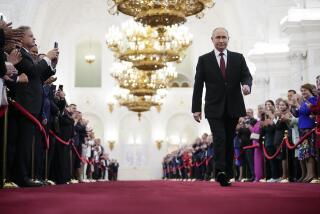Yeltsin Sees Russia Becoming Stable : Economy: President says worst of reform-era spasms are over. Others call outlook grimmer.
- Share via
MOSCOW — President Boris N. Yeltsin asserted Wednesday that Russia, which has enjoyed relative political and economic calm for the last few months, is on its way toward real stability, with the worst of reform-era spasms over.
“The economy is gradually stabilizing. By the end of the year, we expect a stable inflation rate of 5% to 6% a month,” he told workers in a Moscow suburb. “The political situation is also stabilizing. . . . Life has become more tranquil.”
Yeltsin’s claims echoed assurances poured on at a recent meeting of major Western companies by Prime Minister Viktor S. Chernomyrdin, who derided investors’ reluctance to risk their money in the Russian economy.
“Russia is a different country today,” Chernomyrdin told business leaders from the likes of Coca-Cola and United Technologies. “The peak of Russian chaos is behind us, and I’m sure this is irreversible.”
Others, of course, are less sanguine. It was just this kind of a suspiciously quiet period that preceded the attempted Soviet coup of 1991; Yeltsin’s fateful decision to disband Parliament last year also came as the brief northern summer--when Russians are too busy toiling in country gardens to play politics--surrendered to autumn.
Those who see a grimmer outlook point to the new state budget finally approved by Parliament last week. It includes a deficit of 70% that is likely to go higher.
They also note the continuing drop in industrial production, which fell by 26% in the first half of this year, the Economics Ministry reported.
Russia, the pessimists say, faces big problems now as it tries to help 1.4 million registered unemployed workers, up by 600,000 since December. The pressure from stalled factories, the jobless and the cash-strapped military makes Russia’s nascent stability far from guaranteed.
But what does appear certain is that Yeltsin and Chernomyrdin are happily using the recent peace to embark on a broad image refurbishment meant to encourage the foreign investment Russia desperately needs.
Government officials say foreign investors have injected only about $1 billion this year, showing less faith in the prospects of mighty Russia than in the economy of the tiny Baltic state of Estonia.
The Kremlin is only beginning active work to attract more foreign money, promising tax breaks and long-term land leases to major investors. Investment is becoming especially critical for Russia because the Kremlin has curtailed its subsidies to industry while selling off thousands of factories to private shareholders.
The next step in revamping Russian industry calls for extensive private investment in modernizing factories that show potential, while those that do not will be allowed to go bankrupt. But Russians clearly lack the billions upon billions of dollars that will be needed to upgrade an industrial base that, at many factories, has not been touched for decades.
Enter the foreign investor, and Yeltsin’s assertion this week to a group of them that “the recent months were the quietest in the political sense during the whole period of reforms.”
Indeed, since the October tumult that left almost 140 people dead in fighting between pro-Yeltsin forces and pro-Parliament rebels, Russia has gotten a new constitution, a new Parliament and a “Civic Accord,” an agreement by political parties, unions and regional leaders to try to work together in peace.
Russia’s image as a somewhat more civilized place has also been bolstered in the last two weeks by its entry into the North Atlantic Treaty Organization’s “Partnership for Peace” program and an agreement with the European Union lifting most trade barriers to Russian goods and recognizing Russia as no longer a state-run economy but rather one “in transition.”
Yeltsin on Wednesday pointed to dropping inflation--now at 9% a month compared to 26% at the start of the year.
Some state statistics also indicate that Russians’ real income has grown by about 10% this year. Virtually all statistics in Russia are considered somewhat dubious. But the signs of some economic easing are visible even on the streets--if only in the floods of bananas, once rare luxuries, now being hawked in Moscow and much of Russia.
Despite the signs of a possible economic end of the tunnel, government and opposition economists agree Russia has a long, long way to go before it will enjoy Western-style, stable prosperity.
Independent economist Pavel Bunich cast doubt on whether the government can continue to keep inflation low, noting that the new budget calls for pumping up the money supply to cover promises of funding for culture, science and an increase in the minimum wage.
But perhaps the most quietly ominous denial that Russia has entered a period of stabilization came from the chairman of the Moscow branch of ultranationalist Vladimir V. Zhirinovsky’s party. The recent period of calm, said Viktor Bogaty, means that “Russian people still haven’t decided what to do. Now is a period of thinking things over, and then we will act.”
More to Read
Sign up for Essential California
The most important California stories and recommendations in your inbox every morning.
You may occasionally receive promotional content from the Los Angeles Times.













